
Damaged Land, Buried Carbon
A Real-World Partnership for a Real-World Problem
Damaged Land, Buried Carbon
Can eroding soil store excess CO2?
Everybody knows erosion is bad, but one of the bad things everybody “knows” may be a bum rap: the charge that erosion is a source of increased carbon dioxide entering the atmosphere. Is erosion a carbon source, or might it be a carbon sink?
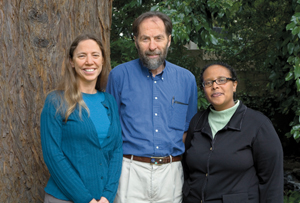
A study of erosion-induced carbon sinks, by Margaret Torn, John Harte, and lead author Asmeret Asefaw Berhe, appears in BioScience. (Not pictured is co-author Jennifer Harden.) photo by Roy Kaltschmidt, CSO
A team of scientists at UC Berkeley, Berkeley Lab, and the US Geological Survey (USGS), writing in the April, 2007 issue of BioScience, report that soil erosion and deposition form a significant carbon sink, which potentially offsets as much as 10 percent of global fossil-fuel emissions of carbon dioxide.
“Erosion is a serious problem, but there’s a silver lining,” says the report’s lead author, Asmeret Asefaw Berhe, a postdoctoral fellow in UC Berkeley’s Department of Earth and Planetary Sciences and a guest in Berkeley Lab’s Earth Sciences Division (ESD). “By conserving lands that have stored this eroded carbon, we can continue to keep that carbon from re-entering the atmosphere as CO2.” Moreover, eroding lands can and should be protected in a way that sustains their valuable productivity, Berhe says.
Co-authors of the BioScience paper, titled “The Significance of the Erosion-Induced Terrestrial Carbon Sink,” are ecologist John Harte of UC Berkeley, soil scientist Jennifer Harden of the USGS, and biogeochemist Margaret Torn of Berkeley Lab and UC Berkeley. The scientists don’t claim erosion is a good thing; rather they say it’s necessary to revisit and revise past estimates of how much of the historic increase in atmospheric CO2 concentration is caused by land-use changes. If some eroded areas are actually carbon sinks, there’s an even greater impetus to conservation.
Torn, who heads ESD’s Climate Change and Carbon Science program, says, “Whether and where soils constitute a net carbon sink or a net source of atmospheric CO2 is an unresolved question, but it clearly depends on local conditions.” Proper accounting is essential because, as she and Harte have shown, loss of the carbon presently stored in soils could contribute to harmful feedback loops that actually accelerate global warming.
Unnatural erosion
Most erosion is caused by deforestation, biomass burning, and poor agricultural practices. Costs to the environment are severe, and human welfare is directly impacted by loss of productive agricultural land, increased flooding, silting of reservoirs, and other damage. The same human activities that cause erosion increase the amount of carbon dioxide in the atmosphere. It’s estimated that land-use changes since the Industrial Revolution have released CO2 equal to three-quarters of the CO2 from fossil fuel emissions.
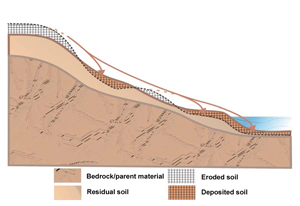
Soil and organic carbon erode into down-slope depositional basins, which if undisturbed form significant carbon sinks.
“Because erosion is such a pressing environmental problem, anything positive associated with it is almost impossible to perceive,” says Berhe. “This may be one reason why the question of whether soil erosion is a net carbon source or sink has been a subject of fierce debate among Earth scientists.”
A large proportion of the carbon that plants take out of the atmosphere cycles through the soil, partly through root systems, where much of it is stored. Decomposing organic matter releases carbon back into the atmosphere. Erosion affects both processes, positively and negatively.
When rich soil is removed by erosion, plant productivity and input of carbon to the soil are reduced. Some nutrient losses can be offset by good farming practices and use of fertilizers; fuel to make fertilizer and run farm machinery is a carbon source, however.
As eroded soil is transported downslope, decomposition may be accelerated, releasing more carbon; however, when the soil is deposited and buried, especially in flooded, low-lying areas, decomposition slows.
“The major goal of our work was to understand not only how much carbon is transported and deposited by erosion, but what mechanisms stabilize this carbon in the soil where it is deposited,” Berhe says. “In particular we were interested in how stable the carbon is in the depositional settings, as compared to the carbon that remains on the eroding slopes.”
To assess the carbon balance, the researchers studied two different watersheds. One, the Tennessee Valley in the Marin Headlands, has been relatively undisturbed for many years, and erosion there occurs naturally — the chief cause being vigorous burrowing by pocket gophers. The erosion rate is low.
The second site was studied by co-author Harden as part of the USGS Mississippi Basin Carbon Project. The Nelson Farm in northern Miss-issippi was cleared from a hardwood forest in 1870 and has been intensively cultivated ever since, with crops like soybeans and hay; rates of erosion are high, although the land continues to be productive because of fertilizer use.

Burrowing pocket gophers are the chief cause of moderate soil erosion in Tennessee Valley.
The researchers found that only a small part of the atmospheric carbon taken up by growing plants and input to the soil ends up in the erosion-induced terrestrial carbon sink — about one percent of the net primary production (plant growth), and about a sixth of all the carbon transported by erosion. The carbon sink at the agricultural site was proportionally bigger than at the wild site, storing 15 times more carbon because of greater erosion and deposition. Most carbon deposited by erosion never leaves its watershed.
Carbon sequestration is not an argument for letting erosion go unchecked. How much eroded carbon is decomposed, during erosion and after it is deposited in different kinds of basins, remains an important unanswered question. The authors argue strongly for controlling erosion in flood-prone areas, degraded soils, and other eroding landscapes with improved agricultural practices such as reducing tillage, the breaking up of soil. A good cover of undisturbed vegetation increases the soil’s potential to store carbon.
“I think the most significant aspect of all this is that as a result of erosion, a significant amount of carbon is stored in the soil by burial and aggregation, which prevents it from being released back to the atmosphere,” Berhe says.
But, she adds, there’s a caveat: “If this sink is disturbed” for example, by dredging, or by dismantling earthen dams, which store a great deal of carbon — “potentially a lot of carbon could be released into the atmosphere. Consequently, conservation lands should be perpetuated to protect those carbon stocks.”
This research was principally supported by the USDA National Research Initiative and additionally by USGS, NASA, and DOE.
A Real-World Partnership for a Real-World Problem
The historic academic-industry partnership called the Energy Biosciences Institute hasn’t begun its work yet, but it is already the hottest topic on campus.
Amid the widespread euphoria of a winning bid by UC Berkeley, and Berkeley Lab to host the EBI — a $500 million, 10-year project funded by BP to create the next generation’s clean-burning biofuels — have come some expressions of concern both within and outside the campus community that corporate influence will compromise the openness and purity of faculty research.
Not so, say the architects of the EBI collaboration, Lab Director Steve Chu and Berkeley Chancellor Robert Birgeneau. In an opinion piece published by the San Francisco Chronicle last Sunday, the two leaders shared their view that “the advanced biofuels we plan to develop must transition from the laboratory to the fuel pump as soon as possible and on a global scale. This is why a partnership with a major energy company such as BP is of fundamental importance.”
They also noted that serving society as universities do “often and properly requires that the work of our scientists and our scholars reach beyond the university walls.” At the same time, they said, “in these partnerships, universities must protect the academic integrity of faculty. The terms of the partnership must be based on fundamental principles that allow for open and timely dissemination of research results. Agreements must respect our primary commitment to the education of our students, and support our ability to make research results available for public benefit in a diligent and timely manner.”
Those terms will be included in the final contract with BP now being negotiated and scheduled for completion around July 1.
Critics have cited their fear that BP will set the research agenda, and that this will threaten academic independence.
In fact, “the EBI research agenda was set by the academic partners,” said UC Berkeley Provost George Breslauer in a Sacramento Bee op-ed. “Academic researchers will propose the projects, which will be evaluated for technical merit and feasibility by outside panels of peer reviewers” in a process similar to that used by the National Science Foundation and the National Institutes of Health.
Academic research partnerships with private and government entities are not unusual. Breslauer points out that the campus receives $500 million a year in government, private and industry funding, so BP’s $50 million per year (shared among the two Berkeley partners and the University of Illinois) will only marginally add to that. The university policies and principles that have preserved the integrity of these other relationships will be applied to the BP contract as well, he said.
The debate has fueled newspaper commentaries and campus discussions within the Academic Senate, including a special meeting yesterday. One outgrowth of these discussions was an agreement by campus administration that four Academic Senate committee chairs will provide input on the draft contract language as negotiations proceed with BP.
Birgeneau and Chu cautioned that universities must also protect the academic freedom of the entire faculty. Faculty who mistrust industrial partnerships should not be allowed to block other faculty who want to partner with industry.
“As long as the source of external funding is not permitted to compromise the core values of a university, additional support provides us with the means to better serve our students, our scholars and society,” they wrote. “EBI will serve as a model for large-scale academic-industry partnerships that will play an increasingly important role in solving the major global problems of the 21st century.”
“Let’s stick to the facts,” Breslauer warned, “and not condemn without basis the real-world partnerships needed to combat the real-world problem of global warming.”
CLIMATE MODELER Joins Earth Sciences Division
Leading climate modeler Bill Collins joined the Earth Sciences Division (ESD) April 6, with a mandate to form a new department dedicated to atmospheric and climate science. Collins is also a professor in residence at UC Berkeley’s Department of Earth and Planetary Science.
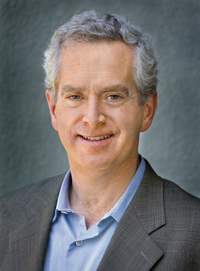
Bill Collins
photo by Roy Kaltschmidt, CSO
Collins earned his B.A. in physics from Princeton and an M.S. and Ph.D. in astronomy and astrophysics from the University of Chicago in 1988. By then, he says, he was already feeling a yen to tackle problems that evolved on a shorter time scale than that of the cosmos “and were directly relevant to society.” Climate change fit the bill and led to postgraduate work at the Scripps Institution of Oceanography.
Collins arrives here from the NSF’s National Center for Atmospheric Research in Boulder, Colo., where he led the development of the Community Climate System Model version 3 (CCSM3), a climate model sponsored by NSF and DOE that ranks among the world’s most powerful. CCSM3’s ability to simulate atmospheric, oceanic, and terrestrial processes underpinned the February report from Working Group I of the UN’s Intergovernmental Panel on Climate Change (IPCC), of which Collins was a lead author, detailing the physical science basis for the IPCC’s conclusions.
At Berkeley Lab, Collins heads an initiative to create a new kind of climate model that integrates cutting-edge climate science, such as the pioneering work on the carbon cycle conducted at Berkeley Lab, and draws on work by scientists at UC Berkeley and other universities and national laboratories.
The goal is not to predict climate alone but interactions among climate, water, and energy on a global scale. Wholly interactive, it will be able to incorporate fresh data and generate new scenarios at any point: energy demand and carbon emissions; changes in the composition of the atmosphere and the heat entering and leaving it; impacts on ecosystems and human well-being; and different strategies to mitigate or adapt to change.
“We want a climate model that works for the long view on the global scale and can also give us a detailed near-future picture on regional scales,” Collins says. “To know how well we’re doing at predicting the future, we’ll confront our models with observations of the past and present climate.”
Ernie Majer, acting director of ESD, declares himself “extremely pleased” by Collins’s arrival and says his work “not only fits into ESD’s future but the Lab’s future goals to build a national center for integrated climate science.”
The Science of Giving: Lab Staff Helps Improve the Lives of Others
Berkeley Lab employees do more than just work together; they also give together, evidenced by a number of Lab-sponsored activities.
Numerous researchers, technicians, and staff volunteer to assist the Center for Science and Engineering Education with educational outreach to K-12 students, undergraduates, and teachers. But Lab staff share more than just professional expertise. Many are also trying to improve the lives of others by volunteering time and donating money for charitable causes.
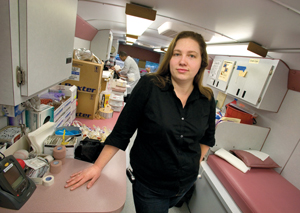 Heather Pinto spearheads American Red Cross blood drives at the Lab. photo by Roy Kaltschmidt, CSO
Heather Pinto spearheads American Red Cross blood drives at the Lab. photo by Roy Kaltschmidt, CSO
Among the programs employees help organize for the Lab are American Red Cross blood drives. Spearheaded by Heather Pinto (with the Lab’s Facilities Division) and Clark Wood (Information Technologies Division), a bloodmobile visits the Lab every two months to help boost supplies for hospital and emergency services.
“I have a rare blood type, O-negative, so I understand the importance of having access to blood should something happen to me,” says Pinto on why she helps arrange the bloodmobile visits. “I want to make sure others can get blood if they need it.”
Seeking even more of an impact on the local community, Pinto, along with Sharon Hernandez (Accelerator and Fusion Research Division), formed a “Philanthropy Club” at the Lab. The group’s first activity, a One-Warm-Coat drive, collected over 180 garments from Lab employees, which were then given to a local charitable organization for distribution to the needy.
And come April 28, low-income seniors and people with disabilities living in Albany, Berkeley, and Emeryville will benefit from the efforts of Berkeley Lab “Energy Teams,” who will install simple energy and water efficiency measures. These include wrapping water heaters, installing weather stripping, cleaning refrigerator coils, and replacing existing faucets and showerheads with water-saving versions, says Allan Chen (Environmental Energy Technologies Division), who helps organize the teams.
Every fall for the last six years, the Lab has sponsored a SHARES (Science for Health, Assistance, Resources, Education and Services) campaign, in which Lab staff can donate a portion of their paycheck to a charity that supports science education and energy conservation, or any 501(c)3 organization of their choosing. Participating groups include the Bay Area Black United Fund, Global Impact, the United Way, and Earth Share.
Lab employees impact society not only by conducting and supporting groundbreaking scientific discoveries, but also with their compassion for others.
Berkeley Lab View
Published once a month by the Communications Department for the employees and retirees of Berkeley Lab.
Reid Edwards, Public Affairs Department head
Ron Kolb, Communications Department head
EDITOR
Pamela Patterson, 486-4045, [email protected]
Associate editor
Lyn Hunter, 486-4698, [email protected]
STAFF WRITERS
Dan Krotz, 486-4019
Paul Preuss, 486-6249
Lynn Yarris, 486-5375
CONTRIBUTING WRITERS
Ucilia Wang, 495-2402
Allan Chen, 486-4210
David Gilbert, (925) 296-5643
DESIGN
Caitlin Youngquist, 486-4020
Creative Services Office
Berkeley Lab
Communications Department
MS 65, One Cyclotron Road, Berkeley CA 94720
(510) 486-5771
Fax: (510) 486-6641
Berkeley Lab is managed by the University of California for the U.S. Department of Energy.
Online Version
The full text and photographs of each edition of The View, as well as the Currents archive going back to 1994, are published online on the Berkeley Lab website under “Publications” in the A-Z Index. The site allows users to do searches of past articles.
Flea Market is now online at www.lbl.gov/fleamarket
Berkeley Lab is managed by the University of California for the U.S. Department of Energy.
Mark Levine and his China Dreams: Former EETD Director has Big Goals for World’s Fastest-Growing Economy
Mark Levine is a gregarious and witty fellow, a leading authority on energy efficiency and, until this past February, director of Berkeley Lab’s Environmental Energy Technologies Division (EETD). Levine had served as EETD’s director since 1996 and stepped down to devote most of his efforts to what has become his scientific passion, the reduction of carbon dioxide emissions in the People’s Republic of China (PRC).
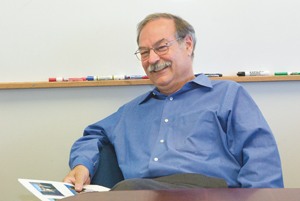

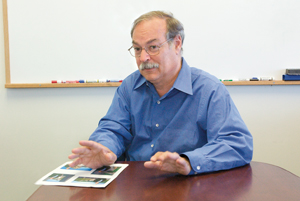 Mark Levine
Mark Levine
“My goal is to reduce CO2 emissions in China as much as possible over the next 10 or more years of my scientific career,” he said. “Right now, China is second only to the United States in greenhouse gas emissions, and they’re fueling their phenomenal economic growth with huge quantities of coal. The enormous global environmental consequences of this coal use will grow to unsustainable levels unless we can help them improve the efficiency of their energy use.”
Towards this end, Levine is the founder and leader of EETD’s China Energy Group, which has been instrumental in conducting research on China’s 2020 Energy Scenarios, and in the development of a national Chinese energy strategy that aims to improve China’s energy efficiency 20 percent by the year 2020. In addition, Levine has been one of the driving forces behind the creation of the China Sustainable Energy Program, a privately funded non-profit and nongovernment foundation that helps to promote and implement energy efficient technologies in the most energy-intense segments of the Chinese economy.
“Being involved in the creation of the China Sustainable Energy Program is the most significant accomplishment of my career,” Levine said. “I had the privilege of working with senior members of the Packard Foundation, joining them on an initial trip to China to meet with senior officials in that country, and designing the initial program with staff of the Energy Foundation. Today the China Sustainable Energy Program plays a highly influential role, with funding from the David and Lucile Packard Foundation, the William and Flora Hewlett Foundation, and other major donors.”
A summa cum laude graduate of Princeton University, who received his PhD in chemistry from UC Berkeley in 1966, Levine came to Berkeley Lab in 1978 after having spent two years with the Ford Foundation Energy Policy Project in Washington, D.C., and four years with SRI International in Menlo Park, mainly doing energy modeling and energy and environmental analysis. At Berkeley Lab he headed the Energy Analysis Program for 10 years before becoming EETD’s director.
Levine’s involvement in China’s energy policies began in 1987 with a phone call from DOE asking him to help organize a workshop on energy markets in China, which was to be held in Beijing. At the time, Levine had already been working for nearly a decade on energy efficiency issues in the Southeast Asian countries of Singapore, Thailand, Malaysia and the Philippines. In putting together the workshop, he learned that since 1980 the demand for energy had risen about half as fast as gross national product (GNP). This was a surprise because the usual scenario for developing econ-omies is that energy consumption increases at a much faster rate than GNP.
“I subsequently learned that the Chinese government had put an energy efficiency policy in place at the start of the 1980s,” he said. “My curiosity was piqued, as I wished to know just how the Chinese had made these achievements. Also, the Chinese wanted to learn about technology from us, as they believed that further progress depended on deploying improved technology.”
Levine soon found himself involved with the Chinese government in an effort that resulted in the establishment of a scientific exchange program, the first collaboration between the U.S. and China involving energy efficiency research.
The exchange program began in 1989. Originally it was a collaboration with the Energy Research Institute (ERI) of China’s State Planning Commission, but has since been expanded to other research organizations, government offices and enterprises. In the early days, Levine said the secrecy of the PRC government was a challenge.
“In the view of the PRC government, the work was so secretive they did not even tell me it was a secret,” he jokes. “The ERI would send scientists here to work with us on making their scientific reports better. So long as these reports were published here, and differed from the reports issued in China, even if they said essentially the same thing as the Chinese version, they weren’t censored.”
This first collaboration, Levine said, provided a “lodestar of information” on energy policies in China, much more accurate and forthcoming than the information from other Communist nations at that time. The reports that were published included the first external assessment of China’s energy conservation efforts, studies that identified prime energy-efficiency opportunities in China, and the China Energy Databook, the most authoritative sourcebook of its kind.
Levine and the Berkeley Lab team went on to help China establish energy efficiency standards for appliances that he believes will result in the savings of more carbon dioxide emissions by 2025 than any other conservation program in the world. He also played a key role in the creation in 1993 of the Beijing Energy Efficiency Center (BECon), an independent nongovernmental organization that promotes energy conservation in China.
Despite his focus on China, Levine has also managed to find time to address the energy policies of the United States. He helped Berkeley Lab energy conservation guru Art Rosenfeld create the highly acclaimed California Institute of Energy Efficiency, and led the creation of the Center for Resource Solutions, a nonprofit organization based in the Presidio of San Francisco that’s devoted to promoting energy efficiency and renewable energy technologies.
Looking back on his tenure as director of EETD, he says his best remembrances include the growth of the battery research program, the creation of a department for the study of outdoor air quality, and the funding support from the California Energy Commission that has helped make it possible for EETD to sustain its leadership role in energy research. He also notes with pride that his old Energy Analysis Group continues to thrive after his departure.
“It showed just how strong and solid the leadership in our group was and continues to be,” he said.
Given that China is by the far the world’s most populous nation, with one of the largest and fastest growing economies, Levine’s early involvement in that nation’s efforts to be energy efficient now appear quite prescient.
“The challenge of meeting China’s future energy needs is daunting, but it also presents a wealth of opportunities for developing improved energy efficiency and clean energy technologies,” Levine said.
He intends to help make the most of those opportunities.
CSI: Berkeley Lab — Judges Educated on Science Issues
It has all the makings of a courtroom thriller: a ship carrying a toxic compound sinks in the Puget Sound, unleashing a spill that threatens an endangered sea slug. Local authorities plan to clean up the mess using bacteria that are designed to digest the toxic slick. Environmental groups, however, sue to keep the bacteria from being released into the water, fearing its engineered DNA will wreak havoc on indigenous microbes. Meanwhile, the spill spreads. The clock is ticking.
For a few hours last month, 55 state and federal judges mulled over the intricacies of this case — but not in an austere courtroom or book-lined chamber. Instead, they sat in the Building 66 auditorium. And the case, although very detailed and seemingly ripped from the headlines, was hypothetical.
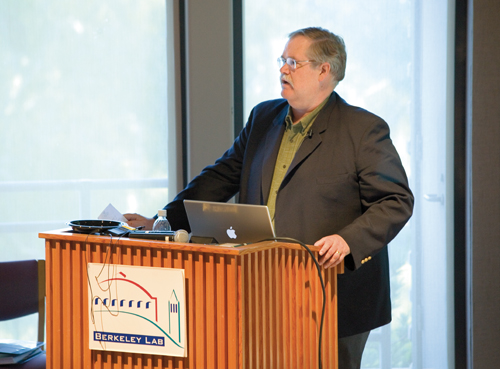 Judges get an orientation to emerging scientific fields from Lab microbial ecologist Terry Hazen.
Judges get an orientation to emerging scientific fields from Lab microbial ecologist Terry Hazen.
It was part of a week-long conference designed to give the judges an orientation to the emerging fields of nanotechnology, synthetic biology, and environmental biotechnology, and enhance their ability to preside over complex cases involving novel scientific evidence. They toured the Molecular Foundry and the Advanced Light Source, met with Director Chu and several other Lab scientists, isolated DNA fragments and examined spectroscopy images, and dissected imaginary cases involving nanoparticles, radionuclide releases, and bioremediation.
“They came to Berkeley Lab because we are known as the center for science, and they need to know how science works,” says Terry Hazen, a microbial ecologist in the Earth Sciences Division who has helped judges bone up on the fundamentals of science for the past eight years.
Hazen organized the March 25 to 30 conference under the auspices of the Advanced Science & Technology Adjudication Resource Center (ASTAR), a non-profit corporation that seeks to improve the capacities of the nation’s courts in resolving highly technical cases. He originally planned to focus on bioremediation and related topics, but the judges asked to expand the conference to tackle a wide range of cutting-edge science. They reasoned that they need to be prepared for whatever scientific evidence enters their courtroom, which is much more than just DNA these days.
“In large part this is due to what the judges call the CSI factor,” says Hazen, referencing the popular TV crime show. “They are getting more and more demand from jurors for a variety of very complex forensic evidence.”
In the hypothetical toxic spill scenario, for example, judges probed the case from several angles, seeking to learn as much as possible about the new technology. “This concept of risk of contamination by horizontal gene transfer — what does that mean?” asked one judge.
Judges also want to be sure that expert witnesses are precisely that — an expert in their field. Hazen and other Lab scientists gave the judges tips on distinguishing good scientists from the not-so-good.
“We want to be able to preside over complex cases, and when expert witnesses come in, sort out the good science from the junk science,” said Michael Mason, a judge in Maryland’s Montgomery County Circuit Court. “Maryland has a growing number of biotech and other high-tech companies, and inevitably, some of their research will end up it the courtroom.”
Judges who attended the conference were certified by ASTAR and will provide case-related leadership later this year at the group’s national conferences. ASTAR’s mission over the next two years is to provide an orientation on the fundamentals of emerging scientific disciplines to every court jurisdiction in the U.S.
Climate Survey Leads to Action at the Lab
The people spoke. Management listened. And now, the work begins.
What started as a first-ever survey of Berkeley Lab employees’ opinions about their workplace is moving into an action phase that promises to respond to the most commonly expressed concerns and issues.
After the data from last summer’s Lab Climate Survey was gathered and published, Lab Director Steve Chu held three brown-bag discussions for those interested in commenting on the results. This additional input has led Chu, Lab Ombudsman Harry Reed, and Chief HR Officer Vera Potapenko toward an aggressive strategy of addressing some of the greatest concerns.
“We’ve listened, we’ve found the common denominators, and now we have to evaluate what enhancements we can realistically make,” Chu said. “Although the majority of the survey responses and follow-up discussions revealed a general pride and satisfaction in our workplace, there are still areas that can be improved to make the Laboratory a greater place to work.”
Chu said the primary issues can be encompassed within four categories — job and career advancement opportunities, quality of supervision (including performance evaluation), communications between management and staff, and work-life balance. He noted that in each category, with management attention and employee input, steps will be taken to strengthen capabilities and processes.
For example, scientists and engineers at the Lab will operate within a more transparent career advancement system. The RPM 2.07 Professional Research Staff Policy eliminates prior uncertainties about which tracks can lead to advancement at the Laboratory. Potapenko said the Berkeley Lab Institute (BLI) will be creating a career development series of classes for scientists and nonscientists, with a target rollout in fiscal year ’08. However, she cautioned that career development “is a personal employee responsibility. The organization and management can provide support and some direction, but it is up to the employees on how they develop and manage their career.”
BLI has already incorporated into its catalogue several training classes to improve the quality of supervision, including “Roles and Accountabilities for New Supervisors” and “The Manager Development Program.” Design of additional training for supervisors, of both scientists and nonscientists, is planned for fiscal year ’08. In addition, Potapenko said Human Resources will begin an assessment of the Performance Review and Development (PRD) process within the divisions to ensure its effectiveness and its utility.
“Performance management and staff development, when it really works, is a mutual shared responsibility between the employee and his or her manager,” she said. “This would be the approach that we would like to incorporate into our process moving forward.”
Under the auspices of the Public Affairs Department, an interdepartmental task force has begun work on a Lab-wide communications plan that will include enhanced Laboratory tools and options to encourage management-staff interaction.
“Some employees think they’re isolated in their jobs,” Reed said. “How much communication takes place in the divisions? We need to encourage systems which allow for staff input, recognition, and dialogue.” He said this area also addresses the issues of civility and respect that are the backbone of the Lab’s Principles of a Diverse Community.
Among the work-life balance issues to be considered are various options for accommodating employee child care.
Looking ahead, Chu said he will continue to engage employees and rely on their input with respect to these issues.
“In five years, what do we want Berkeley Lab to look like?” Chu asked. “That is the task ahead, and we intend to continue to solicit the opinions of our employees as we strive to meet our goals. Their comments so far have been invaluable in our efforts to craft the kind of workplace that everyone will appreciate and embrace, and I thank them for their interest.”
Outstanding Student Ivy McDaniel Exemplifies DOE’s Science Undergraduate Laboratory Interns
Last month, just 10 minutes before presenting a seminar on the identification of fungi to an audience that included Terry Hazen, Hoi-Ying Holman, Tamas Torok, and other leading microbiologists, student intern Ivy McDaniel learned that she had received a 2007-2008 Goldwater Scholarship, considered the premier undergraduate award of its type. Among the 317 winners nationwide this year, McDaniel is the only one from Alaska.
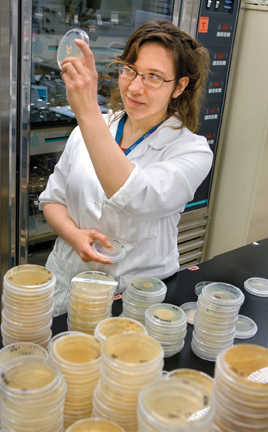 Goldwater Scholarship Recipient Ivy McDaniel
Goldwater Scholarship Recipient Ivy McDaniel
McDaniel is a junior at Scripps College, where she majors in molecular biology. As one of nine DOE Science Undergraduate Laboratory Interns (SULI) currently at Berkeley Lab, McDaniel exemplifies an outstanding group of young researchers:
Interns Adam Hall from Bowdoin College and Trang Elizabeth Huynh of DePaul University are working with Brett Singer; Greg Rybka of Penn State with Robert Van Buskirk; Courtney War of Chico State University with Marc Fischer; and Yola Bayram of the University of Michigan, Dearborn, with Ashok Gadgil. All are in the Environmental Energy Technologies Division.
Brad Barquest of UC Berkeley is an intern with Peggy McMahan, and Dylan Gorman of Contra Costa College with Paul Vetter, in the Nuclear Science Division.
Roger Basu of UC Berkeley is an intern with Ramamoorthy Ramesh in the Materials Sciences Division.
McDaniel’s mentor is Tamas Torok of the Life Sciences Division; she works in the Center for Environ-mental Biotechnology. Her own path to Berkeley Lab — and, she hopes, eventually to graduate work at UC Berkeley — began in the woods near the small city of Wasilla in central Alaska, where her father was a home builder. Her mother encouraged her curiosity.
“She would take me out to dig around in fossil beds, or help me dissect owl pellets to assemble rodent skeletons,” says McDaniel. One holiday season the only present McDaniel wanted was “one of those big model torsos with removable organs.”
Courses at Claremont College with biologist Jennifer Armstrong confirmed McDaniel’s fascination with the living world. “She was truly born to do research,” Armstrong says.
Torok seconds that opinion. “Ivy is working with yeasts and filamentous fungi. From growing the organisms all the way to aligning the edited biomarker sequences for species identification, Ivy is doing it all with a dedication, ease, and professional curiosity I have not seen in a student, ever.”
McDaniel’s presentation on methods of using ribosomal DNA in the hunt for new fungal species will be one of a series of presentations by the SULI undergraduates beginning at 9:00 a.m. on Tuesday, April 25, in Bldg. 50, room 5132. Talks are scheduled every 20 minutes until noon. For a detailed schedule contact Robbie Jackson at x5437. Berkeley Lab’s SULI program is administered by Laurel Egenberger of the Center for Science and Engineering Education (CSEE).
Engineering Shops Open to Users
Molecular Foundry scientist Stefano Cabrini faced a challenge as he prepared to use a cross-beam electron microscope in the Foundry’s clean room. He needed a little “stage” to hold down the optic fibers on which the ion beam would focus. So he presented his idea to research technician Erin Wood, and together they designed a three-inch aluminum disk with mini-tower, angled at 54 degrees to match the microscope’s line.
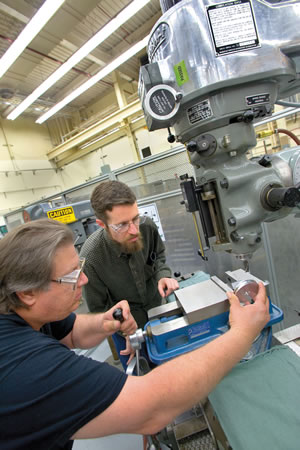 Chief machinist Steve Ferreira (left) assists researcher Erin Wood from the Molecular Foundry at the Building 77 Regional Research Shop.
Chief machinist Steve Ferreira (left) assists researcher Erin Wood from the Molecular Foundry at the Building 77 Regional Research Shop.
Now, where to build it? Wood checked with colleague Ed Wong, who directed him to the Building 77 Shops. There, Wood found all he needed — including expertise and guidance from machinist Steve Ferreira.
“I had never used those tools,” said Wood, telling how Ferreira taught him how to safely operate a lathe and a milling machine. “He’s very knowledgeable and explains everything. I learned a lot and had a great time. I can’t wait for the next project.”
He fabricated the part he wanted in about two days. The experience is a perfect example of why the new Regional Research Shop was established by the Engineering Division.
“We are committed to provide a comprehensive working shop environment for researchers on the Hill,” said Alan Paterson, Division Deputy for Mechanical Engineering. “We provide a broad stock of resources for researchers, so they don’t have to have their own shops and worry about paying for maintenance or management from their research budgets.”
Guy Pulsifer, manager for central fabrication at the Shops, says the set-up is perfect for “quick-turn” projects, especially for researchers in the eastern part of the Lab. The precision resources include lathes and milling machines, drill presses, sheet metal forming tools, sanders, grinding wheels and — most important — trained experts to help get the work done.
This regional research shop emerged from consolidation of several smaller engineering shops and is available to users weekdays from 7 a.m. to 3 p.m. Ferreira (x2525) or Ed Tully (x5907) will make the arrangements with new customers.
Berkeley Lab Science Roundup
Quantum Secrets of Plants
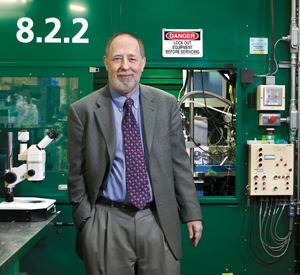
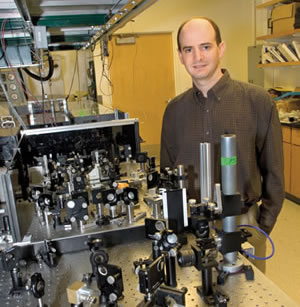 Graham Fleming (top) and Greg Engel
Graham Fleming (top) and Greg Engel
Photosynthesis makes any short list of Mother Nature’s spectacular achievements. For example, through photosynthesis, green plants and cyanobacteria are able to transfer sunlight energy to molecular reaction centers for conversion into chemical energy with nearly 100 percent efficiency. Little energy is lost because the transfer takes place almost instantly. How photosynthesis accomplishes this near-instantaneous energy transfer is a long-standing mystery that may have finally been solved.
Deputy Lab Director Graham Fleming led a study that identified a quantum mechanical effect as the answer. Using a technique called 2-D electronic spectroscopy, Fleming and a team that included Greg Engel, of the Physical Biosciences Division, obtained the first direct evidence of wavelike motions of excitation energy that can simultaneously explore all potential energy pathways in a molecular system and choose the most efficient one. The evidence came in the form of “quantum beating” signals, coherent electronic oscillations in both donor and acceptor molecules, generated by light-induced energy excitations, like the ripples formed when stones are tossed into a pond. Electronic spectroscopy measurements made on a femtosecond time-scale showed these oscillations meeting and interfering constructively to form the wavelike motions of energy. This finding contradicts the classical description of the photosynthetic energy transfer process as one in which excitation energy hops from light-capturing pigment molecules to reaction center molecules step by step down the molecular energy ladder.
Northern (and Southern) Exposure
 Photos of the aurora before a substorm (left) and during a substorm when the single auroral splits into several ribbons or into clusters (Images by Jan Curtis via NASA)
Photos of the aurora before a substorm (left) and during a substorm when the single auroral splits into several ribbons or into clusters (Images by Jan Curtis via NASA)
Discovering what causes auroras — the mysterious Northern and Southern Lights — in the Earth’s atmosphere to dramatically change from slowly shimmering waves to wildly shifting streaks of color is one of the driving factors behind the NASA space mission dubbed THEMIS. Among the critical components of the THEMIS mission are custom-built silicon diode detectors, which were made in Berkeley Lab’s Microsystems Laboratory by Craig Tindall, Steve Holland and Nick Palaio of the Engineering Division. These detectors are helping to collect data on how charged particles in the solar wind interact with Earth’s magnetic field to shape the magnetosphere — the area of space around the earth that’s controlled by our planet’s magnetic field. THEMIS stands for Time History of Events and Macroscopic Interactions during Substorms. The mission consists of five different coordinated spacecraft, which were launched from Cape Canaveral together aboard a single rocket this past February. Onboard the spacecraft are solid-state telescopes (SSTs) that utilize the Berkeley Lab silicon diode detectors to measure the energy distribution of electrons and ions arriving at each spacecraft from different parts of the sky. The detectors have very thin contacts, only a few hundred angstroms thick, that allow them to detect electrons and ions with energies much lower than those that can be detected with standard silicon detectors. This advantage enables the SSTs to cover a wide energy range, from high to low. There are 80 of these silicon diode detectors aboard the five spacecraft.
Energy-Efficient Digital Networks Project
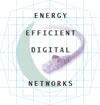
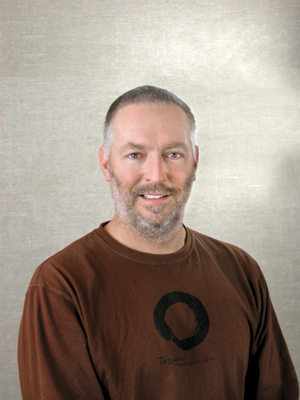
 John Busch (left) and Bruce Nordman
John Busch (left) and Bruce Nordman
John Busch, a scientist in the Environmental Energy Technologies Division, is the principal investigator for the Energy-Efficient Digital Networks project, a Berkeley Lab research effort aimed at developing technologies that will make electronic networks — whether they are used for the Internet, consumer electronics, or both — more energy-efficient. Project members, including principal contact Bruce Nordman, are also working with industry to develop specifications and information programs that will speed the adoption of energy-efficient technologies in the marketplace. Studies suggest that total energy consumption of electronics in the U.S. is more than 70 trillion watt-hours per year of electricity, costing billions of dollars, and equivalent to at least 50 million metric tons of carbon dioxide emissions per year. Most of these electronics are already networked, and the number of devices continues to grow. Some estimates suggest that one-third of this energy could be saved with full use of power management on desktop computers. Although power management programs are common to electronic devices, a lot of PCs fail to engage their power management features because they don’t stay connected to the Internet when they go into power-saving modes. The Energy-Efficient Digital Networks project has three components related to networks, and three addressing consumer electronics.
Tons of Opportunity for DUSEL

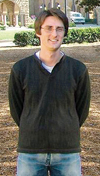 Nikolai Tolich
Nikolai Tolich
How old is the earth? How much energy does our planet radiate? Is there a naturally occurring nuclear reactor in the core of the planet? To find answers to these and other question, Nikolai Tolich, Yuen-Dat Chan, Patrick Decowski, Brian Fujikawa, Kevin Lesko and Alan Poon, of the Nuclear Science Division, along with Joseph Wang, in the Earth Sciences Division, and former Berkeley Lab scientists Charles Currat and Reyco Henning, have submitted a proposal for the construction of a one-kiloton (1,000 tons) neutrino detector that will be used to study electron antineutrinos which come from the uranium and thorium decay within the earth’s core. This detector would be located at the site of the Deep Underground Science and Engineering Laboratory (DUSEL), which has yet to be named. The energy from uranium and thorium decay is thought to be the most significant energy source inside the earth, hence the primary factor behind tectonic plate movements, volcanoes and earthquakes. Observing electron antineutrinos from uranium and thorium decay will provide a more direct measure of the total uranium and thorium content in the earth and therefore a more direct measure of the earth’s heat production. This in turn should yield a more accurate picture of Earth’s geologic history. For example, scientists once believed the earth was approximately 100 million years old, but we now know the planet is several billion years old. The proposed detector will be comprised mostly of purified oil whose hydrogen atoms will interact with the antineutrinos to create positrons and neutrons. These particles will then produce two flashes of light inside the detector that can be recorded. The deep underground location and a buffering tank of heavy water will help reduce background noise that makes neutrinos difficult to detect. This proposed new neutrino detector could also serve as a monitor for nuclear power plants.
George Smoot Seeds Education With donation of his Nobel Prize Money
In a March 22 press release, the East Bay Community Foundation announced that George Smoot had converted money awarded by the Nobel Committee as part of his 2006 Nobel Prize in Physics into a donor-advised charitable fund to further science education. Donor-advised funds are held in the donor’s names and managed by the Foundation, but the grants go to charities named by the donor.
 George Smoot
George Smoot
Smoot’s new fund will be used to sponsor graduate and post-doctoral fellowships. In addition, Smoot will provide matching grants to UC Berkeley to establish a science center for high-school students. Smoot has also established the Berkeley Center for Cosmological Physics, a Berkeley Lab-UC Berkeley consortium with a strong emphasis on education and public outreach.
Smoot shared the 2006 Nobel Prize with NASA’s John Mather for their studies of the cosmic microwave background radiation. His longstanding interest in science education has led him to sponsor numerous undergraduates, graduate students, and postdoctoral fellows in the Lab’s Physics Division and related cosmology programs in other divisions; he has been a visiting teacher and guest lecturer locally, nationally, and abroad.
“I saw two ways to use the prize money,” Smoot was quoted as saying in a San Francisco Chronicle editorial. “First, I could give the government half of it in taxes and use the rest to pay off my mortgage and maybe buy a new car. Second, I could take all of it and hopefully get matching donors and that way help out so many more young people who need to get launched in their careers. I thought it was more important to help people who could carry on the work, and maybe even develop a new way of thinking about the universe.”
Smoot used the metaphor of seeds to describe both his work and his gift to charity. “My scientific work has been all about seeds growing under gravity to galaxies and clusters of galaxies into the Universe,” he said. “Using Nobel prize funds to assist good causes is about joining with others to grow a critical mass of philanthropy.”
The East Bay Community Foundation, serving Alameda and Contra Costa counties, was formed in 1928 as the first public foundation in Northern California. It manages more than 400 charitable funds and endowments totaling almost $270 million. The Foundation has benefitted in the past from donations by Berkeley Lab researchers, including Albert Ghiorso, who established two donor-advised funds in the names of Glenn Seaborg and nuclear scientist Mike Nitschke. Former Berkeley Lab chemist John Rasmussen administers one of Ghiorso’s funds and has made his own donations to the East Bay Community Foundation.
People, Awards, and Honors
Two From Lab Named To UC Diversity Council

 (L-R): Reed, Johansen
(L-R): Reed, Johansen
UC President Robert Dynes has announced the appointment of the University of California Staff Diversity Council, and two Berkeley Lab employees are among the inaugural group — Ombudsman and Workforce Diversity Head Harry Reed (left), and business manager Bill Johansen. Reed will represent the national labs, and Johansen will represent the UC Staff Association (CUCSA). Dynes said he established the council to advice senior UC leadership and work with the existing UC Diversity Study Group in setting an agenda that promotes staff diversity throughout the system.
MSD Guest Wins Prestigious Award
 Jones
Jones
Rebecca Jones, a guest in the Materials Sciences Division and a UC Berkeley Materials Sciences and Engineering graduate student in Eugene Haller’s group, will receive the prestigious Ross N. Tucker Award of the American Institute of Mining, Metallurgical, and Petroleum Engineers on April 27 at the 35th Annual Northern California Electronic Materials Symposium in Santa Clara, CA. The award memorializes Ross N. Tucker, who contributed significantly to the advancement of materials used in semiconductor electronics. Jones performs research under the joint guidance of Wladek Walukiewicz and Haller on semiconductor nitrides, a recent class of semiconductors used in light-emitting diodes, and which also hold great promise in future high-efficiency photovoltaic solar cells.
JGI Wins ‘Ergo Cup’ Competition
Emerging from a record field of 28 finalists representing many major multi-national companies, a team of scientists and engineers from the Joint Genome Institute and Berkeley Lab won the 2007 Ergo Cup. The JGI’s “Shake ‘N Plate” instrument took the prize for the “team-driven workplace solutions” category at the 10th Annual Applied Ergonomics Conference. The winning innovation, “Shake ‘N Plate,” is a simple device designed to alleviate upper body fatigue associated with bacterial culture plating. The winning team included Christine Naca, Martin Pollard, Diane Bauer, Catherine Adam, Simon Roberts, Karl Petermann, Charlie Reiter, Ira Janowitz, Karli Ikeda, Miranda Harmon-Smith, Sanna Anwar and Damon Tighe.
Lab’s Joe Gray Selected For Cancer Study Board

 (L-R): Gray, Werb
(L-R): Gray, Werb
Berkeley Lab’s Associate Laboratory Director for Life and Environmental Sciences, Joe Gray (left), has been elec-ted for a three-year term as board member for the American Asso-ciation for Cancer Research, the oldest and largest scientific organization in the world focused on every aspect of high-quality, innovative cancer research. He was among a slate of new officers announced by the AACR, which also included Zena Werb, a Berkeley Lab biologist who was named to the Nominating Committee.
Student Intern Wins Goldwater Scholarship
 McDaniel
McDaniel
Ivy McDaniel, a junior at Scripps College and one of nine DOE Science Undergraduate Laboratory Interns (SULI) currently at Berkeley Lab, is working this semester in Tamas Torok’s laboratory in the Life Sciences Division’s Center for Environmental Biotechnology. In March, McDaniel learned she had received a Goldwater Scholarship for 2007-08, considered the premier undergraduate award of its type. Of the 317 winners nationwide, McDaniel is the only one from Alaska.
International Cancer Research Prize for Bissell
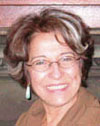 Bissell
Bissell
Berkeley Lab Life Scientist Mina Bissell is the recipient of the 2007 Pezcoller Foundation-AACR International Award for Cancer Research for her pioneering work on the relationship between cancer genetics and the three-dimensional structure of cells and tissues. Bissell is a Distinguished Scientist here and a recognized leader in the study of the extracellular matrix (ECM) — the complex physical and biochemical environment that surrounds living tissues — and how it regulates genes in both normal organs and malignant tumors. “I am honored to be the recipient of this prestigious award, and I thank the selection committee as well as the past and present members of my group for their hard work and vision,” said Bissell.
Computing Expert to Lead Undergrad Math Projects
 Meza
Meza
Juan Meza, head of Berkeley Lab's High Performance Computing Research Department, along with two graduate assistants will lead 12 students in math research projects as part of the 2007 Mathematical Sciences Research Institute Undergraduate Program (MSRI-UP). The program seeks to increase the number of undergraduate students from underrepresented groups in mathematics graduate programs. MSRI-UP includes summer research opportunities, mentoring, workshops on the graduate school application process, and follow-up support.
Materials Scientist Wins Griffith Prize
 Ritchie
Ritchie
Rob Ritchie, with the Lab’s Materials Sciences Division, was chosen by the Institute of Materials, Minerals and Mining in London as the recipient of its A.A. Griffith Medal and Prize for 2007. The award, named after the pioneer in fracture research, is given “in recognition of distinguished work which has made, or is making, a notable contribution to any branch of materials science.” The award will be presented to Ritchie at the Institute’s annual dinner in London in July.
Director Talks on ‘Helios’ Monday
Members of the Berkeley community will get a chance to learn more about the Helios Project and development of alternative energy sources at Berk-eley Lab in a three-talk series of free public lectures that begins Monday. Lab Director Steve Chu will kick off the series at 5:30 p.m. when he discusses “The Energy Problem: What the Helios Project Can Do About It.” He will be followed by Paul Alivisatos on May 14 (“Nanoscience at Work: Crea-ting Energy From Sunlight”) and Jay Keasling on June 4 (“Renewable Energy From Synthetic Biology”). All talks are in the Berkeley Repertory Theatre.